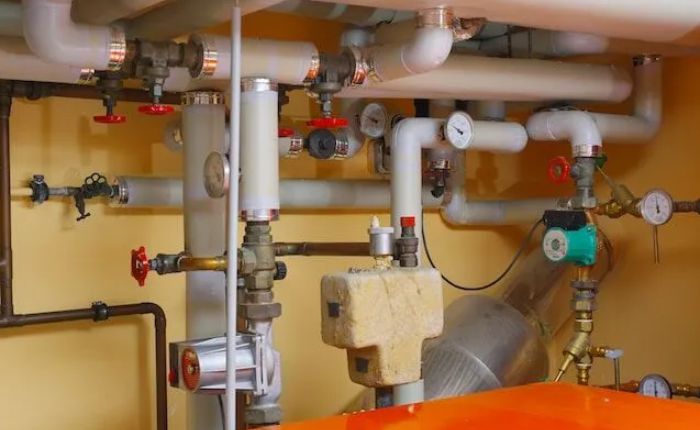
-
Pipes
Pipes are the primary conduits used to transport water, gas, or sewage within a building or structure. They come in various materials, each with its own advantages and applications.
Copper Pipes: Copper pipes are durable, corrosion-resistant, and can withstand high temperatures, making them ideal for both hot and cold-water distribution systems. They are commonly used in residential and commercial plumbing installations.
PVC Pipes: PVC (polyvinyl chloride) pipes are lightweight, cost-effective, and resistant to chemical corrosion. They are commonly used for drainage, waste, and vent (DWV) systems, as well as for cold water supply lines.
PEX Pipes: PEX (cross-linked polyethylene) pipes are flexible, easy to install, and resistant to freezing. They are often used for residential plumbing systems and radiant floor heating applications.
Galvanized Steel Pipes: Galvanized steel pipes are strong and durable, but they are prone to corrosion over time, especially when used for hot water distribution. They are commonly found in older plumbing systems.
Cast Iron Pipes: Cast iron pipes are heavy-duty and highly resistant to mechanical damage, making them suitable for underground drainage and sewage systems. However, they are less commonly used in modern plumbing installations due to their weight and cost.
-
Fittings
Fittings are used to connect and join sections of pipes, allowing for changes in direction, branch connections, and transitions between different pipe materials.
Couplings: Couplings are used to join two pipes of the same size and material together in a straight line. They are typically secured with screws, clamps, or solvent cement, depending on the pipe material.
Elbows: Elbows are fittings that allow for changes in direction within a plumbing system. They are available in various angles, including 90 degrees, 45 degrees, and 22.5 degrees, and can be made of metal or plastic.
Tees: Tees are fittings that allow for branch connections in a plumbing system, creating a T-shaped junction between three pipes. They are commonly used in water supply lines and drainage systems.
Reducers: Reducers are used to transition between pipes of different diameters, allowing for a change in pipe size within a plumbing system. They are available in concentric and eccentric designs.
Adapters: Adapters are fittings that allow for connections between pipes of different materials or thread types. They are often used to connect PVC pipes to copper pipes or to adapt to different pipe sizes.
-
Fixtures
Fixtures are devices that are connected to the plumbing system to provide access to water or drainage. Common fixtures include sinks, faucets, toilets, showers, and bathtubs.
Sinks: Sinks are used for washing hands, dishes, and food preparation. They typically consist of a basin, a faucet for water supply, and a drain for wastewater disposal.
Faucets: Faucets, also known as taps, are used to control the flow of water from the plumbing system. They come in various styles and designs, including single-handle, dual-handle, and touchless models.
Toilets: Toilets are fixtures used for human waste disposal and sanitation. They consist of a bowl, a flushing mechanism, and a trapway that connects to the drainage system.
Showers: Showers are fixtures used for bathing and hygiene. They typically consist of a showerhead, a mixing valve to control water temperature, and a drain to remove wastewater.
Bathtubs: Bathtubs are fixtures used for bathing and relaxation. They come in various shapes and sizes, including standard alcove, freestanding, and whirlpool models.
-
Valves
Valves are devices used to control the flow of water within a plumbing system, allowing for isolation, regulation, and redirection of water flow.
Gate Valves: Gate valves are used to fully open or close the flow of water within a pipe. They are commonly found in main water supply lines and are operated using a wheel or handle.
Ball Valves: Ball valves use a spherical disc with a hole to control the flow of water. They are quick to operate and provide a tight seal, making them ideal for applications where precise control is required.
Check Valves: Check valves allow water to flow in one direction only, preventing backflow and ensuring the integrity of the plumbing system. They are commonly used in sewage ejector systems and sump pumps.
Pressure Reducing Valves (PRVs): PRVs are used to regulate the pressure of water entering a building or structure, reducing it to a safe and manageable level. They help protect plumbing fixtures and appliances from damage due to high water pressure.
Thermostatic Mixing Valves (TMVs): TMVs are used to control the temperature of water flowing from a fixture, ensuring a safe and consistent temperature for bathing and handwashing. They are commonly used in showers and sinks.
Conclusion
Understanding the basic components of plumbing is essential for anyone involved in building, maintaining, or repairing plumbing systems. In this module, we have covered pipes, fittings, fixtures, and valves, highlighting their functions, materials, and applications. By mastering these fundamental elements, you will be better equipped to tackle plumbing projects with confidence and efficiency.
